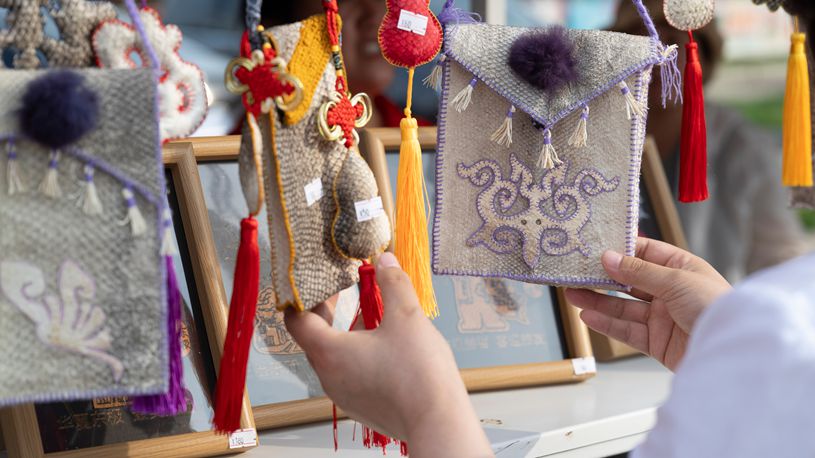Xinhua Headlines: From mountain villages to world stage, young Chinese revive ethnic culture
Source: Xinhua
Editor: huaxia
2025-07-04 18:40:47
* In recent years, China has placed great emphasis on cultivating representative inheritors of intangible cultural heritage.
* Once hidden in remote mountain villages, intangible heritages like Miao embroidery, Dong songs and traditional batik are now gaining global recognition through the efforts of young Chinese creators.
* With digital tools, global platforms, and bold creativity, young Chinese are reimagining traditions as powerful cultural exports.
GUIYANG, July 4 (Xinhua) -- Across the southwestern highlands of China, ancient cultural practices -- Miao embroidery, Dong songs and traditional batik -- have long thrived in mountain villages, passed down through generations.
Once isolated by geography, these intangible heritages are now gaining global attention, thanks to a new generation of young Chinese creators.
With digital tools, global platforms, and bold creativity, they are reimagining traditions as powerful cultural exports.
YOUNG DESIGNERS REVIVE HERITAGE
Yang Chunlin, a 36-year-old ethnic-Miao designer, is turning his cultural roots into fashion statements that resonate with the world.
In 2013, Yang founded his fashion label "Gu Axin," echoing his Miao name, as a tribute to the embroidery heritage passed down by his mother and grandmother.
By fusing traditional Miao symbols with trendy streetwear designs, he created a signature piece -- a Monkey King T-shirt with Miao embroidery. The piece struck a chord with young buyers and sold over 10,000 units.
His fashion initiative "Village T," the "T" being short for "Tradition" and "Trend," has transformed embroidery and batik into performance art.
In 2024, Yang led village artisans to runway shows in Paris, London and Berlin, introducing Miao silverwork, hand-dyeing and embroidery to an international audience.
Videos of the campaign clocked up tens of millions of views, with over 500 runway events and 40 ethnic groups participating. The shows attracted audiences from more than 20 countries and brought in over 250 million yuan (about 34.95 million U.S. dollars) in tourism revenue.
What sets "Village T" apart is its "live heritage" approach -- moving beyond museum displays to show intangible culture in motion.
Yang's shows are not only about fashion, but also about dignity and pride. Many of the embroiderers, mostly elderly women, had never left their villages. Now, they walk international runways in traditional dress, becoming vibrant representatives of Chinese ethnic identity.
Looking ahead, Yang plans to develop "Village T" into a world-class brand by empowering local artisans, fostering creative collaborations, and building platforms that connect heritage with global fashion.
"We've let the world see us," he said, "Next, we'll let them understand and love us."
LOCAL PLAYERS SHOWCASE CULTURE
In Rongjiang County in the southwestern province of Guizhou, a grassroots football tournament has evolved into a cultural movement.
Launched in 2023 with 34-year-old media innovator Wang Yongjie as one of its initiators, the "Village Super League," or "Cun Chao," has become a world-class sports sensation, generating over 100 billion views online and sparking global discussion.
Behind the phenomenal popularity lies a deeper story.
What makes "Cun Chao" unique is its deep integration with local heritage. During halftime, spectators enjoy performances of Dong songs, Miao drum dances and Bouyei folk opera. Winning teams receive handcrafted prizes such as batik scarves and birdcage art. Cheerleaders wear traditional costumes, becoming ambassadors of living culture.
Central to its viral success was Wang's conviction that culture, not just competition, was the true force of connection. He left a stable job to build a new media team from scratch, guiding young creators to tell authentic stories of village life.
Since its launch, "Cun Chao" has welcomed over 17 million visitors and generated more than 20 billion yuan in tourism revenue. It has attracted nearly 30 teams from countries such as France, Brazil, Argentina, Liberia and Cambodia as well as coverage from over 20 international media outlets, including the BBC and Kyodo News.
Most importantly, it has turned rural villagers into global cultural storytellers, showing the world that heritage lives not only in artifacts, but also in the everyday joy of collective celebration.
ETHNIC SINGERS REIMAGINE TRADITION
At the opening of China's record-breaking animated film "Ne Zha 2," the screen blooms with lotus flowers as an ethereal polyphonic song fills the theater.
It's a centuries-old Dong song, performed by 28-year-old Yang Xiangni and her youth ensemble, proud representatives of Guizhou's Sanbao Dong village.
The haunting, unaccompanied harmonies -- recognized by UNESCO as Intangible Cultural Heritage -- were discovered by the film's music team through one of Yang's social media videos.
The collaboration marked the first time Dong songs featured in a global box office hit, introducing millions of viewers to the power and beauty of ethnic Chinese music.
Yang has made it her mission to preserve and evolve Dong music. She returned home to establish a community learning center, digitized rare songs sung by elders, and created cross-media works -- including original music for video games.
Her efforts show how intangible heritage can be both preserved and adapted, speaking to new generations in new forms.
"We hope the mountain drumbeats and songs will resonate globally through cinema and Chinese youth will write a new legend of cultural metamorphosis with youthful confidence," said Yang.
Their stories reflect a broader cultural awakening across China -- one where young people are no longer just inheritors of tradition, but active, confident narrators of a national identity.
China's intangible heritage has gained increasing global recognition, with over 40 elements inscribed on UNESCO's Intangible Cultural Heritage list -- the most of any country.
In recent years, China has placed great emphasis on cultivating representative inheritors of intangible cultural heritage.
By March, a total of 942 individuals had been recognized as part of the sixth batch of national-level inheritors, many of whom are highly skilled and respected figures playing key roles in heritage preservation.
China's youth are showing that internationalizing intangible cultural heritage isn't about copying tradition unchanged, but about continuous creative innovation, said Ma Yongheng, professor at Kaili University in Guizhou.
(Video reporters: Liu Qinbing, Zhou Xuanni; video editors: Wu You, Roger Lott, Zhu Cong) ■













Comments